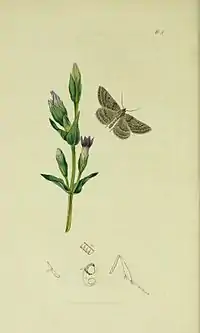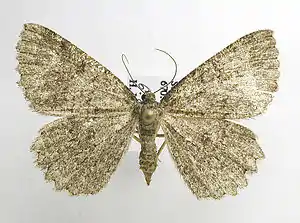Charissa obscurata
Charissa obscurata, the annulet or Scotch annulet, is a moth of the family Geometridae. The species was first described by Michael Denis and Ignaz Schiffermüller in 1775. It is found in most of Europe.

| Charissa obscurata | |
|---|---|
 | |
| Scientific classification | |
| Kingdom: | |
| Phylum: | |
| Class: | |
| Order: | |
| Family: | |
| Genus: | |
| Species: | C. obscurata |
| Binomial name | |
| Charissa obscurata (Denis & Schiffermüller, 1775) | |
| Synonyms | |
| |
It is a variable species, whose ground colour generally reflects the area it inhabits. It is whitish or pale grey in limestone and chalky districts. Darker forms are found in areas with peaty soils. The circular O marks on all four wings are typical but may be vague. The forewings have strongly toothed lines, whose which continue on the hindwings. The margin of the large hindwing is very heavily ruffled and incised, which differ from other species of Charissa moths.[1]
The wingspan is 27–32 mm. Adults are on wing from July to August.
The larvae feed on various herbaceous plants, including Calluna species, Viscaria vulgaris, Sedum telephium and Rubus species.
Melanism and evolution
The British entomologist Albert Brydges Farn (1841–1921) wrote to Charles Darwin on 18 November 1878 about his observation that colour variations in the annulet moth related to soil colour. He suggested this was an example of "survival of the fittest", and added that he had found dark moths on a chalk slope where foliage had been blackened by smoke from lime kilns.[2] This was an early observation of industrial melanism, but Darwin does not seem to have responded.[3]
References
- de:Trockenrasen-Steinspanner
- Farn, A. B. (18 November 1878). "Farn, A.B. to Darwin C.R. , Darwin Correspondence Project Letter 11747". The Darwin Papers. Manuscripts Room, Cambridge University Library, West Road, Cambridge, England. DAR 164:26.
- "How an extraordinary letter to Darwin spotted industrial melanism in moths". Science Focus. 27 February 2018. Retrieved 16 June 2018.
External links
| Wikimedia Commons has media related to Charissa obscurata. |